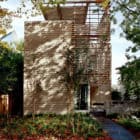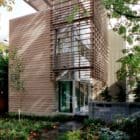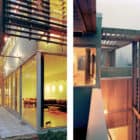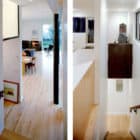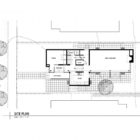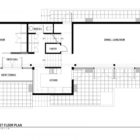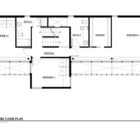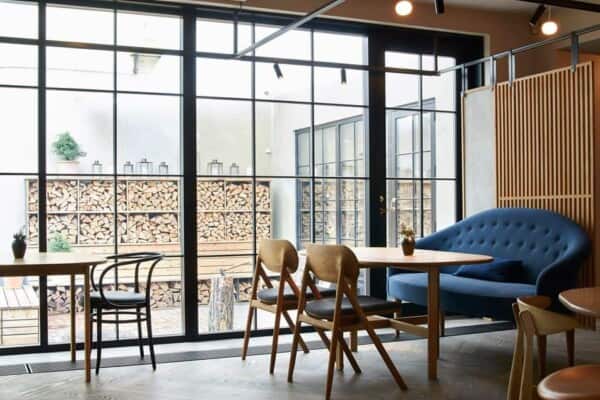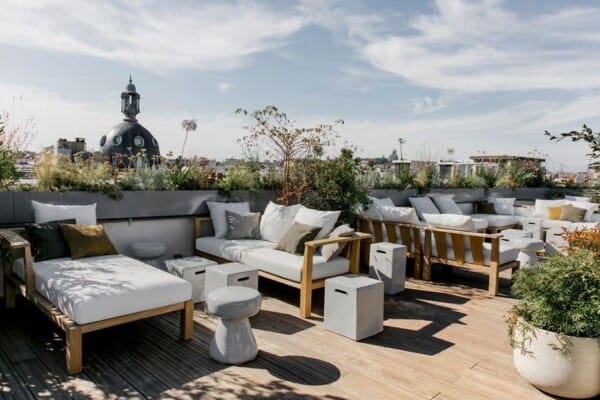Designed by Vandeventer + Carlander Architects for a young couple, the Madrona residence in located in Seattle, Washington.
Sited on a narrow thirty-five foot urban lot, the house design maximizes access to natural light and views yet maintains privacy.
Its south facade features large expanses of glass protected by a cedar sun screen.
Madrona Residence by Vandeventer + Carlander Architects:
“The Madrona Residence is the synthesis of site utilization, building technology, and client program. This synthesis results in a contemporary home respectful to its traditional setting while allowing the owners the space, light, and exterior spaces the property affords.
A substandard lot measuring 35 feet wide by 105 feet deep, the site is located mid-block along a wonderful residential street lined with a row of large, animated maple trees. From the sidewalk, the property slopes gently away to the east with an existing rockery defining the rear property line. Common to many of the houses on the street are the following: first there is a consistent setback from the sidewalk, second nearly all the homes encompass the full width of their lots, and third most of the homes are a full two stories in height with roofs at the zoning height limit. Detail and character vary from neo-colonial to Seattle bungalow in style.
The clients, a young married couple, prescribed a typical domestic program including three bedrooms, an office, and a workshop space.
Additionally, the husband was interested in having a rooftop terrace to take advantage of views to the east of Lake Washington and the Cascade Mountains, while the wife requested ground level terraces and gardens adjacent to the primary entertaining spaces. Being unaccustomed to Seattle’s long winter gray skies, they both spoke to the need for abundant natural light, however privacy was also important given the confined urban site. These requirements resulted in a 3,000 square foot home with the program distributed over four levels. Employing a cantilevered wood screen to provide sun control and privacy, the design features large expanses of glazing along the south elevation.
The design’s conceptual diagram is composed of three elements: a primary extruded volume containing most of the program, a smaller secondary volume to the south, and the cantilevered wood screen. The primary form is five meters wide by eighteen meters long and is located on the north side yard setback. This allows for four meter wide terraced yards along the south side of the house. Floor to ceiling glazing opening onto these yards reinforces the interior to exterior adjacency and provides for the full penetration of natural light. The smaller volume, appended to the primary block just forward of center, divides the southerly side yard into two spaces, a public terrace at the front and a private ground floor terrace and garden at the rear.
The front terrace, raised 3 feet above grade, responds to the street and front entry, while the lower rear terrace relates to the living, dining and kitchen areas. Whereas the elevated entry terrace corresponds to the front porch precedent established by neighboring homes, the raised height when compounded with the site’s falling grade also enables a standard 8 foot ceiling height at the entry to become 11 feet at the living, dining and kitchen areas. Above, the top level of the primary volume contains an office penthouse surrounded by rooftop terraces. For privacy and sun control, the cantilevered wood screen, supported by thin steel supports, wraps the upper levels of the main volume and protects strip glazing on the south, west, and east elevations.
In plan, functions are located about an efficient central stair and service core. At ground level, the entry and television room are west of the core with the living and dining functions to the east. The kitchen occupies the smaller volume south of the core. On the second floor, the bedrooms radiate from the core with the master bedroom and bath being located to the east. On the top level, the stair core opens up into the office penthouse.
Structurally, a row of steel columns allows for continuous floor to ceiling glazing along the south side of the ground floor. Wrapping the end corners and engaging the east and west elevations, this glazing provides visual connection to both the street and the rear yard. The steel columns extend to the roof level thus permitting continuous strip windows at the upper floors. This extensive glazing coupled with punched window openings in the north wall allow for abundant natural light and cross ventilation in the bedrooms.
The east, west, and north exterior shear walls of the primary volume are sheathed with horizontal red cedar slats on battens creating a rain screen wall. At the glazed wall conditions, solid spandrel areas are painted fiber cement panels where joints carefully align with the storefront mullions. This treatment creates a neutral grid accentuating the qualities of the adjacent wood surfaces. The secondary block containing the kitchen and a second floor bedroom is sheathed in tongue and groove cedar, echoing the main volume but creating a lighter massing.
Whereas the design meets the program’s quantitative and qualitative requirements, it is the introduction of the wood screen that unifies and coalesces the project into a whole. The slats of the screen intermesh with the slats of the cedar rain screen – the void of the screen intersecting with the solid of the mass. It provides for summer sun protection while admitting winter light. More importantly, the screen affords privacy yet provides for views. This openness and abundance of light coupled with the high degree of privacy are unique in the urban environment.”
Source: Architizer, Contemporist



















